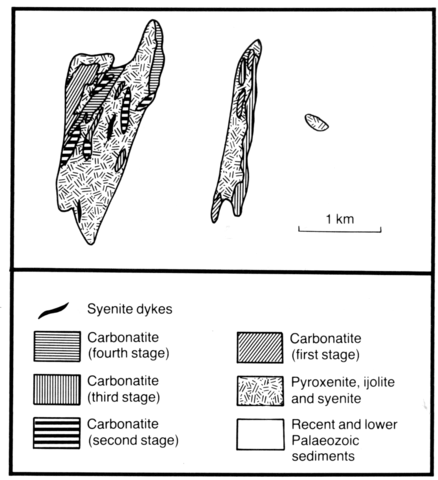stripes
This occurrence, with an area of 3 km2, takes the form of a stock which cuts limestones and mixed carbonate-terrigenous sediments of lower and middle Cambrian age. Judging from the nature of the bedding at the contacts it is presumed that the intrusion is lens-shaped and expands downwards, the pipe-like body being inclined steeply to the south. Carbonatites occupy more than 40% of the area of the intrusion with the rest formed by intensively carbonated silicate rocks. It is considered that the intrusion was formed initially of pyroxenites and alkaline rocks, including ijolites and peralkaline syenites. Calcite carbonatites are the most abundant but the composition depends on the nature of the surrounding rocks such that pyroxenite is replaced by augite-diopside-calcite carbonatite, ijolite by aegirine-diopside-calcite carbonatite, and peralkaline syenite by aegirine-calcite and biotite-calcite carbonatites. Secondary minerals, including epidote, albite and calcite, are widespread and form narrow veins and patches. Ù34So/oo values of sulphides in calcite carbonatite and ankerite carbonatite range from -0.5 to -2.0 (Grinenko et al., 1970).
EPSTEIN, E.M., PANSHIN, I.P., MORALEV, V.M., VOLKODAV, I.G. 1972. On the vertical zonality of the massifs of the ultrabasic-alkaline rocks and carbonatites. In A.I. Ginzburg (ed) Geology of the ore deposits of the rare elements. 35: 49-69. Nedra. Moscow.
GRINENKO, L.N., KONONOVA, V.A. and GRINENKO, V.A. 1970. Isotopic composition of sulphur of sulphides from carbonatites. Geokhimiya. Akademiya Nauk USSR. Moscow, 1: 66-75.

